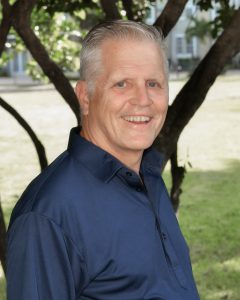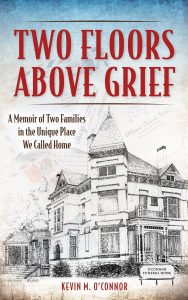 Author and speaker Kevin O’Connor has found that using family letters enriches a memoir by bringing past feelings into the present and adding to characterization. He kindly agreed to elaborate on some of what we chatted about on the Writing & Editing podcast.
Author and speaker Kevin O’Connor has found that using family letters enriches a memoir by bringing past feelings into the present and adding to characterization. He kindly agreed to elaborate on some of what we chatted about on the Writing & Editing podcast.
When did you realize your family’s letters would be an asset to your memoir (Two Floors Above Grief)?
I began saving the letters as they were written and received, starting with a letter my grandfather wrote to his six children in 1937, followed by a letter written by my mother while on her honeymoon with my father in 1939. The writing and the saving of the letters continued into the 1970s. From 2005-2007, I began to organize and catalog the letters. I’ve known for 30+ years that I wanted to write a fiction or nonfiction book. I decided on the family memoir idea about five years ago. As I started the ideation and conception stages of the writing, I realized that the letters would be an asset to the stories.
How did you approach family members to let them know you wanted to reprint the letters in the book?
I didn’t formally approach them. Most were unaware that so many letters had been written AND saved. When I told them I was writing the book, I included references to the letters. During the process, I shared some of the letters with them to help them understand family history.
 In our podcast chat, we talked a bit about character and how the letters gave them each an accurate representation of their individual voices. Do you think this would have been possible to get across to this degree without this type of material?
In our podcast chat, we talked a bit about character and how the letters gave them each an accurate representation of their individual voices. Do you think this would have been possible to get across to this degree without this type of material?
Great question. Through my ideation and outlining process, I was comfortable realizing the stories I wanted to share with my extended family and the world of readers beyond my family. As I draft ideas and writing, I would recognize something like, “Hey, there’s a letter that ties right in with my thinking.” Since I had already organized the letters by date, I went to the section of my notebook where I thought a resource was located. Most times, I found the letter. The content supported my thinking. The discoveries I made in each letter’s content increased the “degree” (the word you use 🙂) to which I could support, enhance, and elevate the story I created. I would not have been able to get across what I did about events, characters, historical connections, and authenticity without the content of the letters.
Was there anything that surprised you in the letters?
Yes. 1. I learned more about my Aunt Mildred’s sense of humor and wit. I read her letters when I first received them and at other times throughout my life. She died in 1971, and her grandchildren ranged in age from 2 to 18. When I wrote the book and told them about my efforts, they said they wanted to learn more about their grandmother. Her letters provided that resource.
- I discovered that my dad, mother, aunt, and sometimes my uncle were writing and mailing letters to me in Rome simultaneously. They did not know the others were writing about the same topics. When I received the letters at the time and through re-reading many years later, I realized the differences in their perceptions.
- An editor commented on the passions conveyed in the letters between my parents and me regarding the differences in our thinking about the student protests of the Vietnam War in 1970. I was glad I could include those letters in their entirety in the book. Some reviewers have commented on how those letters taught them about that part of history and how their lives connected with it.
How did it feel to read about past versions of yourself or to revisit old beliefs, feelings, and ideas?
It has been revealing, impressive, reflective, and appreciative. Although I did not write journals or diaries, the letters have provided a glance into how the life and thinking of my younger years carried through to my senior years.
Did you ever find evidence of people having two different versions of the same event or story?
Yes, see the above comments.
How did you balance these multiple perspectives in the memoir?
I included the letters in their entirety. I did not write much commentary about the differences that I perceived. I want the reader to notice those differences and interpret them in their way.
How do you keep the letters organized?
I have an online course I have offered in a presentation. I have plans to offer this course in other venues. There are resources online about how others have organized letters. I am confident the way I proceeded can help others. Here is the process I used:
- I removed the cards’ letters from their envelopes and paper-clipped each letter to the corresponding envelope. I found stories inferred in the envelope, stamp, and postmark. Some of the correspondence was on aerograms (who uses those now? These are a bit of history in themselves).
- I purchased plastic sleeves with three notebook holes. I put each correspondence into a sleeve. I bought tabs to stick to the side of each sleeve. I put the date of the letter or postmark on the tab.
- By the time I finished, I had approximately 500 plastic sleeves containing the artifacts.
- I put them in a pile. I reserved a space in one of my house’s rooms. I designated sections of the floor representing decades. I put the letters first according to decade. Then, I went to each decade pile and sorted the letters by year, month, and date. Eventually, the letters were organized by date from the 1930s through the 1970s.
- I place the sequenced plastic sleeves into 4-inch three-ring binders.
- I labeled the binder with the dates of the letters.
- The files have been with me through my moves from Illinois to Florida and to three different locations in Florida. They are now on a shelf in my home’s closet. I used these notebooks to find the letters I wanted to include in the book.
Was this the first system you came up with or did you try other methods before this one?
My organization was the first system I used. I have an elementary school teaching background, and my first job was as a Kindergarten teacher. In the kindergarten and elementary years, a central part of the curriculum is sequence by number, alphabet, etc. I used the teaching skills I imparted to my students to organize my collection of letters.
What parting advice do you have for someone who is eager to start writing their own memoir but doesn’t know where to begin?
The beginning can be the most challenging part. For me, I had so many ideas from the stories I had lived, but I didn’t know where to start. So, I just started. I know that sounds too simple, but I learned not to be afraid of making a mistake. I sought out an online class about nonfiction writing. I don’t think I would have progressed as well in my writing without the direction and support of the class.
My advice is to find support from a writing group or class. There are many sources and options available through Google and social media searches. The lessons teach and encourage writers to create a mission/vision and steps to follow. Create a schedule to work. A routine. A discipline. Stick to it. I committed 4-5 hours a day M-F (sometimes on weekends) from 11 AM to 4. Each day, I picked up from where I had left off the day before. I started in May 2021. I kept to my schedule. By October 1, I had completed a first draft of 140,000 words. Then, I took a month-long break to take a trip I had planned for many years.
The key for me was to stop talking to myself and others about writing the book and to begin by getting support and creating self-discipline.
Thanks again, Kevin!
Visit Kevin’s website:
http://kevinoconnorauthor.com
Find Kevin on social media:
https://www.facebook.com/kevin.oconnor2
https://www.instagram.com/kevmaster62/
https://www.linkedin.com/in/kmoconnor/
